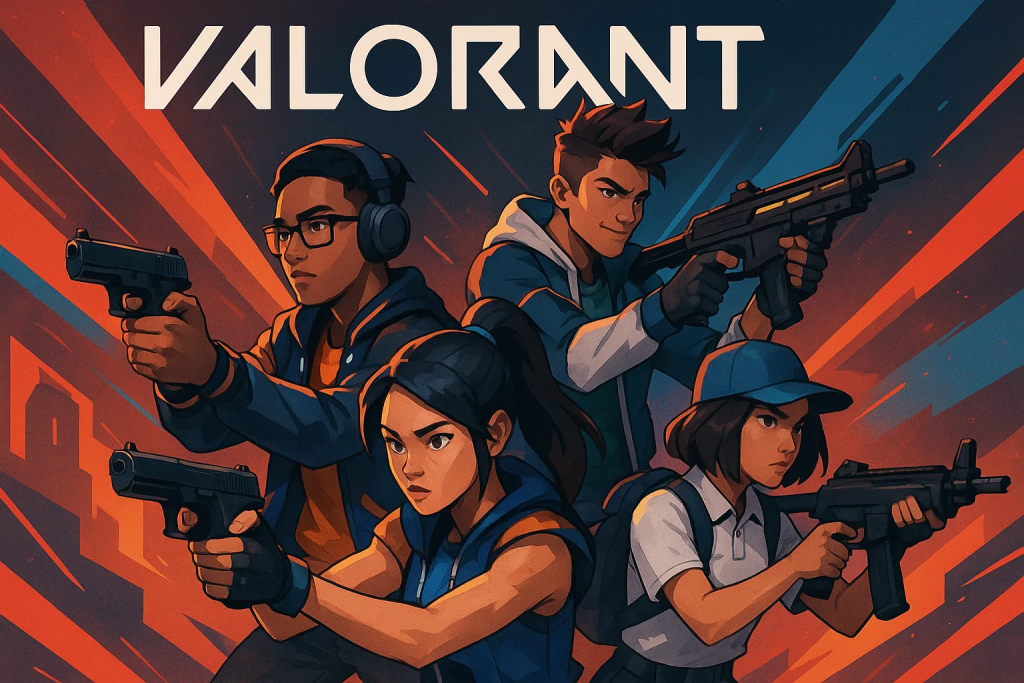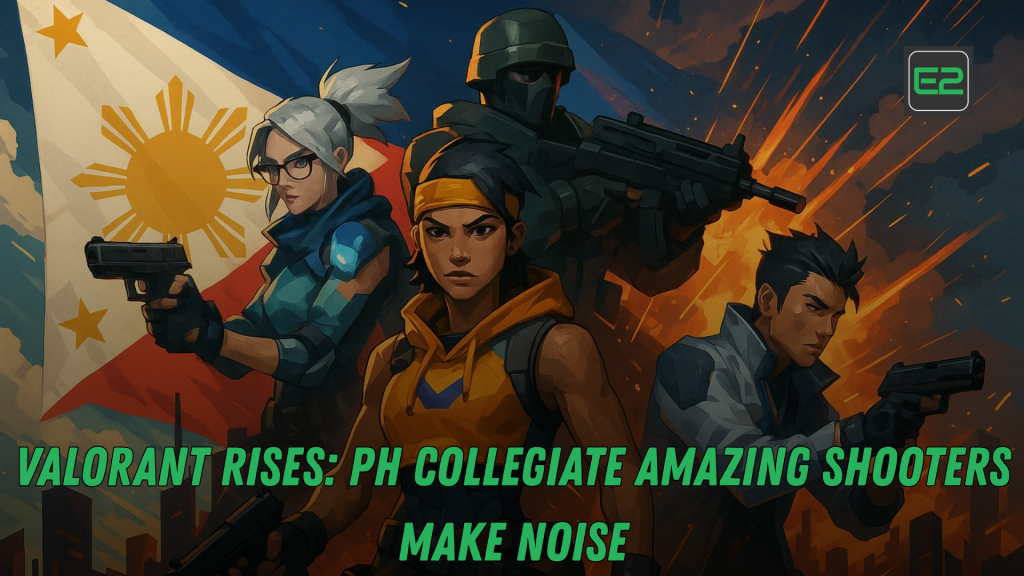Table of Contents
At the center of that momentum sits PH collegiate Valorant, a student-powered ecosystem that blends competition, creativity, wellness, and career prep into one after-class laboratory. Philippine campuses have always been loud—cheering squads, debate teams, drumlines—but the newest sound is the click of mice and the roar of broadcast chats. This long-form guide unpacks how PH collegiate Valorant became a reliable engine for belonging and skill-building, what universities can do to grow it responsibly, and how student players can transform semester grind into life-long opportunities.

Why this rise matters now
The return of in-person school brought a hunger for tribes, stories, and structured fun. Clubs needed modern stages, campus media needed fresh beats, and administrators wanted proof that esports could teach teamwork, discipline, and grit. PH collegiate Valorant solved that equation by pairing a five-player tactics game with broadcast-friendly storytelling and a bilingual, social-native audience. When schools frame PH collegiate Valorant as both sport and studio—practice room by night, internship pipeline by day—participation stops being a fad and starts becoming a culture.
What makes the Philippine scene unique
Three advantages differentiate campus teams across the archipelago. First, students are digital polyglots: English and Filipino flow on air and on timelines, widening reach. Second, many universities sit near fiber backbones or carrier hotels, enabling stable scrims and production uplinks. Third, volunteerism is strong; organizations stretch small budgets with meticulous run-of-show plans and hand-me-down gear. Put together, these ingredients let PH collegiate Valorant punch above its weight, delivering events that feel professional without losing student warmth.
A blueprint to build a program from zero
Whether you’re a faculty adviser, a student captain, or an IT staffer, you can stand up a season-ready program in one term using this 12-step framework:
- Map the ecosystem. List clubs, labs, alumni, local cafés, and vendors who care about PH collegiate Valorant.
- Define governance. Draft a charter that clarifies coach, captain, analyst, observer, and production roles for PH collegiate Valorant.
- Publish a calendar. Plot tryouts, scrims, LAN showcases, exam weeks, and recovery windows around PH collegiate Valorant league commitments.
- Secure infrastructure. Prioritize latency, headsets, audio isolation, and ergonomic chairs; performance and well-being improve together in PH collegiate Valorant.
- Set selection standards. Combine aim and decision-making tests with attitude screens; culture compounds wins in PH collegiate Valorant.
- Codify training blocks. Alternate macro theory with mechanics labs; post goals in the team Discord tied to PH collegiate Valorant maps.
- Establish wellness norms. Sleep, nutrition, cooldowns, and screen breaks are non-negotiables inside PH collegiate Valorant practice.
- Design content workflows. Create a highlight pipeline—clips, stat cards, and explainers that de-jargonize PH collegiate Valorant for families.
- Volunteer academy. Train table staff, observers, replay ops, and social producers so PH collegiate Valorant shows run on time.
- Safety and conduct. Publish a code of respect, moderation rules, and escalation steps for PH collegiate Valorant events.
- Sponsor kit. Package outcomes—attendance, hours watched, portfolio pieces—so partners see the value of PH collegiate Valorant.
- Feedback loop. Hold retros after milestones; deploy small fixes weekly to keep PH collegiate Valorant experiences improving.
Recruiting and developing campus talent
Great rosters begin with curiosity and character. Scout open lobbies, evaluate VODs for pace control and utility trading, and rotate IGL candidates to observe communication discipline. For first-years, teach the foundations—crosshair placement, economy tracking, post-plant spacing—before experimenting with spicy comps. Pair rookies with seniors in a mentorship chain; few resources build confidence faster in PH collegiate Valorant than a veteran who remembers first-scrim nerves.
A four-phase training cycle
- Orientation: Vocabulary, win conditions, role archetypes, and an overview of PH collegiate Valorant etiquette and rules.
- Execution: Set pieces, post-plant decision trees, anti-eco protocols, and mid-round calls tuned to PH collegiate Valorant tempo.
- Adaptation: Drills for recovering control after losing pistol, calming the room, and reframing the next two rounds within PH collegiate Valorant.
- Integration: Constraint scrims—no ops for a half, fast hits only, delayed defaults—so instincts widen and PH collegiate Valorant plans survive chaos.
The campus meta is its own beast
University leagues are wonderfully messy. Opponents rotate slower, ult economies swing, and info discipline varies. Scout opponents to craft day-of plans, but keep “evergreen habits” central: trade discipline, clear mid-round authority, and pace shifts that break predictability. On attack, define two primary win conditions and rehearse them until the room breathes together—this is the heartbeat of PH collegiate Valorant success. On defense, set an aggression budget so gambles feel intentional rather than impulsive; composure is the strongest cosmetic in PH collegiate Valorant.
Content that converts casuals into fans
Matches end; stories travel. Assign student reporters to shadow the roster, publish week-in-review diaries, and capture pre-game rituals. Short explainers—thirty seconds on a failed retake or a perfect lurk timing—invite non-players to appreciate PH collegiate Valorant without needing a primer. Human beats matter too: a team dinner, a post-loss huddle, a relief laugh after a close map. When kindness sits next to competitiveness, PH collegiate Valorant feels like community rather than just a scoreboard.
Health, academics, and longevity
A sustainable scene respects bodies and books. Ban late-night scrims during exam weeks; schedule blue-light breaks and neck-shoulder mobility between maps; encourage journaling in which each player lists two wins, one lesson, and one carry-forward habit. Sustainable practice hours and clear boundaries keep grades high and burnout low—the invisible stats that often decide a season in PH collegiate Valorant.
Event operations that feel professional
Respect for time is respect for people. Start on schedule, post brackets early, and keep a visible help desk. Train observers to catch story beats—ult trades, clutch set-ups, and eco steals. Draft a run-of-show: countdown, anthem, caster handoffs, trophy walk. Crisp execution turns modest budgets into big-show vibes and makes PH collegiate Valorant compelling for parents and alumni who are tuning in for the first time.
Sponsorships that make sense for students
Partners care about measurable outcomes and positive association. Offer naming bundles tied to student-made content, internship fairs, and small scholarships. Demos should solve game-day problems—hydration, eye care, hand health—so partners create real value around PH collegiate Valorant. Draw a firm line around academics: this is an education lab first. Sponsors who respect that boundary stick around longer, and PH collegiate Valorant remains authentic rather than ad-driven.
After graduation: pathways beyond the bracket
Not everyone goes pro, but everyone can go professional. Editors become motion designers; IGLs become project managers; analysts become data interns; social leads become community managers. Frame experience from PH collegiate Valorant as teamwork under pressure, process improvement, and audience growth—verbs employers recognize. Alumni who see that translation keep returning as mentors, building a loop that sustains PH collegiate Valorant year after year.
Inclusion and code of conduct
Welcoming rooms win seasons. Create onboarding for women and nonbinary players; enforce zero tolerance for slurs; give moderators clear authority to act. Provide camera-off options for privacy and bandwidth; design harassment reporting that is simple and humane. When people trust the space, they speak sooner, learn faster, and stay longer—a competitive advantage baked into the culture of PH collegiate Valorant.
A sample week for coaches
- Monday (Review): VOD breakdown, three focus clips, walk-throughs on site hits that match PH collegiate Valorant homework.
- Tuesday (Mechanics): Aim labs, utility lineups, two 45-minute scrims with one explicit experiment for PH collegiate Valorant pacing.
- Wednesday (Wellness): No scrims; mobility, journaling, and light team-building.
- Thursday (Scouting): Role swaps for flexibility; eco-round rehearsals relevant to campus-level PH collegiate Valorant.
- Friday (Dress rehearsal): Two maps, then a checklist drill for set-piece timing that translates into calmer PH collegiate Valorant starts.
- Weekend: Tournament or rest; Sunday debrief with action items for the next PH collegiate Valorant block.
Measuring what matters
Track attendance, tactical execution, mental resets, and content reach. For execution, measure entry success on rehearsed hits, post-plant survival, and trade percentage. For mindset, log “call-and-response” recoveries: how often does the room reset after a lost round? Dashboards should drive behavior change, not vanity. When numbers teach, PH collegiate Valorant practice gets tighter without becoming joyless.
Common mistakes and quick fixes
- Over-scrimming. Swap one scrim night for a classroom block; learning a concept once can save ten rounds inside PH collegiate Valorant.
- Rigid roles. Cross-train so exams or internet outages don’t collapse PH collegiate Valorant lineups.
- Content sprawl. Pick two formats and execute consistently so PH collegiate Valorant storytelling compounds.
- Sponsor over-promise. Under-commit, over-deliver, and protect the student vibe that makes PH collegiate Valorant watchable.
Case studies (composite)
- City Tech Tigers: A “learners-first” culture—no-ego VOD rooms, rotating IGLs, wellness checklists—doubled retention and halved tilt time across one year of PH collegiate Valorant.
- Bayview University: A tiny budget trained observers and editors; streams achieved longer watch time than richer rivals, proving production literacy is leverage in PH collegiate Valorant.
- North Peninsula College: Peer mentoring and exam-week adjustments produced the roster’s best GPA and deepest playoff run—academics and performance can rise together in PH collegiate Valorant.

Map laboratories and agent coherence
Don’t memorize everything; design tests. Run “map labs” where the team tries role swaps and agent synergies that suit campus-level tempo. Track comps that generate the highest plant percentage and the healthiest post-plant spread. Encourage flexible agents to anchor a side on defense and roam on attack, but keep mid-round authority with a single voice. Simplicity scales when pressure spikes—a lesson that carries over to every bracket of PH collegiate Valorant.
Budgeting smart: where each peso matters most
Spend on core quality first: reliable internet, clean audio, ergonomic seating. Next, budget for volunteer comfort—snacks, water, transport allowances. Morale purchases often improve broadcasts more than overlays. Track every expense in a simple ledger and publish a one-page recap; financial clarity builds trust and sets up bigger grants that amplify PH collegiate Valorant the following term.
Volunteer training that scales
Create a two-hour “flight school” covering fundamentals: miking casters, slating segments, clipping replays, and resetting stages. Pair rookies with veterans through a buddy system. Post laminated checklists at each station so anyone can step in. Programs that invest once enjoy smoother shows all season, modeling the reliability that keeps PH collegiate Valorant attractive to alumni and partners.
Hybrid and remote coaching for commuter campuses
Commuter realities are normal. Blend in-person scrims with remote theory on weeknights. Use asynchronous feedback—timestamped notes on VODs, audio comments on clips—to keep learning continuous. Flexible structure widens participation and raises retention, ensuring that PH collegiate Valorant reaches students who juggle classes, jobs, and home responsibilities.
Travel, LANs, and inter-school collaboration
Live events magnify energy—and risk. Co-host with nearby schools to share costs, crew, and barricades. Use modular stage plans that fit different rooms and run a full radio drill the night before. Invite campus medical groups to staff first aid. Clear wayfinding for restrooms and exits turns families into repeat attendees and gives PH collegiate Valorant a reputation for care as well as hype.
Alumni networks and career bridges
Graduates are your secret weapon. Invite them to run mini-workshops on production, portfolio building, or job hunting. Launch a quarterly newsletter highlighting internships and open roles. When alumni see impact, they donate time and gear, feeding a flywheel that transforms PH collegiate Valorant into a talent pipeline for creative and tech industries.
Research and analytics as a capstone
Treat the season like a living dataset. Let statistics or CS students build dashboards that track economy outcomes, retake success, and watch-time per segment. Share insights with coaches and casters so storytelling tightens. Publish a short annual report that explains what changed and why. Rigor makes programs legible to decision-makers and sponsors, strengthening PH collegiate Valorant beyond anecdote.
Media literacy and digital well-being
Teach players and staff to navigate attention. Cover privacy settings, moderation tools, consent in filming, and crisis protocols. Normalize social breaks after big weekends. Healthy relationships with visibility protect mental health and keep PH collegiate Valorant joyful for the people who make it possible.
Accessibility and inclusion beyond the roster
Design events for everyone: ramps where possible, quiet rooms for sensory breaks, accurate captions on highlight reels, and high-contrast graphics on broadcast overlays. Recruit diverse casters and producers, not only players. When more people can show up safely, PH collegiate Valorant grows wider, kinder, and more resilient.
Semester blueprint: from kickoff to championship
- Weeks 1–2: Town hall, sign-ups, and baseline tests; publish a calendar and a one-page guide for families that explains PH collegiate Valorant.
- Weeks 3–5: Foundations—terminology, economy rules, positional concepts—plus simple player cards to introduce PH collegiate Valorant rosters.
- Weeks 6–8: Strategy labs per map, controlled scrims, and the first live broadcast to showcase PH collegiate Valorant.
- Weeks 9–11: Midterm pause with light practice and wellness focus; sponsor showcase of student portfolios tied to PH collegiate Valorant outcomes.
- Weeks 12–14: Rivalry week, charity showmatch, and a community clinic for high schoolers curious about PH collegiate Valorant.
- Weeks 15–16: Playoffs, awards, and a public retrospective; archive everything with tags for easy search next PH collegiate Valorant season.

The big picture: what success looks like a year from now
Imagine a campus where freshmen know exactly how to join, parents know where to watch, faculty know whom to contact, and sponsors know what they’re supporting. Broadcasts start on schedule, tournaments feel safe, and every thank-you lands. Students parlay production reels and leadership logs into internships. Alumni return as mentors. That’s a living ecosystem: a self-renewing PH collegiate Valorant culture that remains joyful even as it grows more professional.
Call to action: pick one concrete step this week
Students—assemble five friends, write a two-page season plan, and email a faculty adviser. Administrators—approve a pilot, appoint a staff liaison, and tour the practice room. Brands—fund a scholarship, underwrite a student broadcast, and craft internships that reward grit. Coaches—publish a calendar and start with a single disciplined block. One small commitment, this week, turns intent into momentum—and momentum is how PH collegiate Valorant keeps rising.
Frequently Asked Questions (FAQ)
1) Our campus PCs aren’t high-end. Can we still field a team?
Yes. Start with stable internet, decent headsets, and ergonomic seating. Schedule scrims during off-peak hours, and focus on decision quality. Many early wins in college scenes come from structure rather than specs.
2) How do players balance classes and tournaments?
Publish the semester calendar early; block exam weeks; favor two-hour focused sessions over marathon scrims. Sleep, nutrition, and cooldowns are part of the plan. A sustainable rhythm protects grades and performance alike.
3) What should we prioritize first: players, production, or sponsors?
Players and production come first. Run a clean stream with good audio and punctuality, then invite sponsors to support something already reliable. Trust grows when partners see consistency.
4) How do we reduce toxicity without killing hype?
Set a clear code of conduct, empower moderators, and script positive rituals—post-match GGs, community shout-outs, and thank-you walls. Hype survives; casual cruelty doesn’t. Healthy rooms produce better matches.
5) Do women’s and mixed rosters have a path to compete?
Absolutely. Build onboarding and scrim schedules that respect safety and comfort, spotlight role models on broadcasts, and enforce zero tolerance for harassment. Diverse rosters strengthen the scene and expand the fan base.

